Short Communication - (2016) Volume 24, Issue 3
Ailsa Reston*
OT, RKS Occupational Therapist, UK
Jon Nock
Director, iDIS Creative Marketing Partnership, UK
Corresponding Author:
Ailsa Reston
OT, RKS Occupational Therapist, Cheshire, UK
Tel: +44(0)7786 245896
E-mail: jon@idiscreativemarketing.co.uk
Submitted date: June 19, 2016; Accepted date: June 23, 2016; Published date: June 30, 2016
This article includes evidence and an exemplary new backrest design to illustrate the benefits of better posture when sitting in a wheelchair for prolonged periods. The author Ailsa Reston qualified as an OT in 1986 and is the co-director of RKS based in Chester. RKS and its independent living showroom provide specialist provision of wheelchairs and seating. This front-line experience has given Ailsa proven knowledge regarding effective wheelchair design and the importance of appropriate lumbar support. In her complete article that can be viewed here, Ailsa introduces the key benefits of sitting in a supportive wheelchair. Through good posture and head, trunk and pelvic alignment, chronic discomfort and pain can be minimized along with the risk of more serious irreversible conditions. Her text progresses onto explaining 'posture' as a definition and the health problems that can result from adopting a poor seated position. Regular or permanent wheelchair users can be prone to a multitude of issues ranging from back pain and fatigue through to Musculoskeletal deformities, Intervertebral Disc Degeneration and reduced Occupational Performance. Ailsa continues to discuss selective evidence that supports the need for wheelchair users to achieve a sustained lorded sitting posture, i.e., a healthy upright posture with natural spinal curvature. Commonly traditional wheelchairs have a vertical backrest that does not promote this position, whereas new designs such as the Strong Back include an arched configuration to encourage an extended posture. The most effective angle, position, shape and material employed within a wheelchair backrest is outlined by Ailsa and supported by comments from the Swiss Strong Back inventors. With backrest ergonomics optimized, wheelchair users can avoid many long-term health problems and enjoy a better quality of life.
Keywords
Wheelchair; Lumbar; Posture; Ergonomics; Occupation; Kyphotic; Lordosis
Introduction
The provision of an appropriate and supportive wheelchair will enable good posture with head, spinal and trunk support and pelvic alignment. This is essential for regular or permanent wheelchair users to facilitate better occupation and well-being through reduced discomfort, back pain or fatigue. However many traditional wheelchairs do not promote good posture and lack appropriate lumbar support which can lead to chronic pain or long term health problems. This article discusses the importance of good posture, appropriate lumbar support and how an example wheelchair design, the TGA Strongback, may provide occupant benefits through a considered ergonomic backrest.
The Definition of Posture
‘Posture is a term that indicates the relative position of the body segments during rest or activity’ Twomey and Taylor.1 ‘Sitting’ is a posture where weight is transferred to the seat of a chair or wheelchair through the Ischial Tuberosities and surroundings soft tissue of the buttocks and thighs. Depending on the wheelchair design, weight is also transferred through the backrest and armrests.
In the context of this article seated posture is as stated in Seeking the optimal posture of the seated lumbar spine, Dr Jennifer Pynt et al.2 ‘Seated posture is defined according to the effect of sitting on the lumbar spine curvature. A flex seated posture is one that reverses the individual’s standing (normally lordotic) lumber curve into a Kyphotic position (forward slouching / backwards slumping). A lordotic or extended seated posture is one that maintains the lumbar curve close to that of an individual’s lordotic standing position (upright/slight rear recline).’
Hence good postural health and reduced discomfort arises from maintenance of lordosis, interspersed with movement – achievable with a wheelchair that incorporates an ergonomically curved backrest and frame as opposed to a traditional upright backrest (Figure 1).
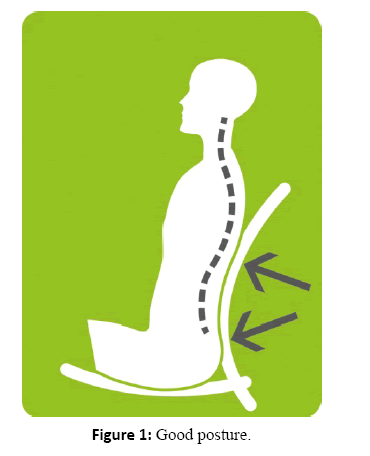
Figure 1: Good posture.
Many Traditional Wheelchairs Promote Poor Posture
Frequent wheelchair users can experience multiple problems associated with poor posture. Without appropriate lateral and backrest support, an occupant’s spine may not achieve a natural position resulting in several issues associated with:
• Reduced Occupational Performance
• Back pain and increased fatigue
• Detrimental affects on internal organ function
• Decreased communication
• Difficulties with breathing, eating and drinking
• Increased risk of spasm
• Musculoskeletal deformities such as Kyphosis and Scoliosis
• Developing Pressure areas
Spinal Cord Injury Peer Support Group, Apparelyzed, provides a useful summary explaining why poor posture is common with users of badly designed wheelchairs and illustrates the resultant problems. “To feel more comfortable or stable, many wheelchair users slump back and slide the buttocks forward in the seat. This type of posture results in a very stable sitting position, but increases the risk of developing posture related health problems. Bad posture can result in reduced lung capacity, back and neck pain, and pressure ulcers. These are some of the most common postural related complaints amongst wheelchair users”.3
“Bad posture and seating of an individual in a wheelchair often leads to musculoskeletal changes over time. If the wheelchair user is not sitting in a correct position, changes to the skeletal system can take place over a number of years, putting additional strain on the spinal column and limbs. These changes alter the efficiency of muscle groups increasing the stress on them resulting in joint and muscle pain”3 (Figure 2).
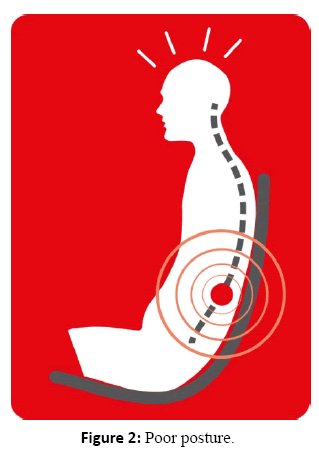
Figure 2: Poor posture.
Preventing Back Pain Through the Lordosed Sitting Posture
There is a variety of evidence to suggest that sitting in a lordotic posture reduces the possibility of many health issues and back pain. It is important to note that pain arising from poor seated posture is insidious and that a wheelchair user’s healthy back, may not register pain until irreversible problems such as Intervertebral Disc Degeneration (IVD) has occurred. Therefore it is essential that a well-designed wheelchair is provided in the early stages of a user’s requirement and that teaching of healthy seated posture is both preventive and therapeutic.
Hedman and Fernie also reported benefits of sitting in a sustained lordosis lumbar position compared with cyphered postures. 4 They discovered that:
• the compressive forces in discs were reduced
• disc shear force was decreased by 75%
• a balancing of forces in Zygapophysial joints
As a definition, Zygapophysial joints (also known as facet joints or z-joints) are located on the posterior of the spine on each side where two adjacent vertebrae meet. The facet joints provide stability and permit the spine to bend and twist. The joint contains cartilage between bones and is surrounded by a sac-like capsule that is filled with synovial fluid.5
If a regular or sustained kyphotic sitting position occured, there was a:
• 9% increase in disc shear force
• large increases in the tensile forces around the posterior annulus
• greater, unbalanced anterior forces in the Zygapophysial joints
• three times the level of force in the posterior ligament on the flexed position than occurred in the anterior ligament in the extended position
Hedman and Fernie referred to the results of the aggregate posterior ligament and force exaction that occur from loading in the flexed posture as ‘alarming’ in terms of potential damage to the posterior ligament and disc.4 Therefore it can be concluded that the potential for IVD and lower back pain is increased when a cyphered (bending forward) sitting position is achieved.
Pynt et al. in summary suggests: ‘Sustained lorded sitting posture (healthy upright posture with natural spinal curvature) decreases disc pressure and thereby disc degeneration, exhibits less injurious levels of ligament tension and although it may increase Zygapophysial loading, this is not of itself considered hazardous to spinal health.2 A sustained cyphered sitting posture (bent, hunched over), on the other hand, increases Intradiscal pressure leading to increased fluid loss, decreased nutrition and altered cell synthesis and biomechanics of the disc, appearing to culminate ultimately in disc degeneration that is a cause of low back pain.
The Importance of an Ergonomic Wheelchair Backrest
A curved convex wheelchair backrest that has been carefully considered in terms of appropriate ergonomics will provide more effective lumbar support and encourage a lordotic or extended seated posture. However the angle and curvature of the backrest must be carefully considered to ensure Hyperlordosis does not occur. Andersson et al. demonstrated that: “if the lumbar support is placed at the level of the sacrum it will have the effect of forcing the buttocks forward, creating lumbar Kyphosis.”6 Further, it was the opinion of Pynt et al. that the apex of the lumbar support is placed so as to maintain the lordosis but not at end of range extension, and such a placement creates pain-free and relaxed position, this will be the optimal location for lumbar support of the seated individual.2
Postural health and reduced pain is more achievable if the lumbar support is appropriate to the degree of individual lordosis. This avoids holding the lumbar spine in sustained hyperlordosis, which causes vertical compression of the Zygapophysial joints and may impinge on the lamina of the vertebra below Bogduk and Twomey, causing pain. The depth of the lumbar support may therefore need to be adjustable to accommodate individual lordosis.7
Sue Hall Head of Physiotherapy and Karen Marshall, Wheelchair and Seating Department Manager at The Royal Hospital for Neuro Disability also state that: “The surface on which the body is resting has an effect on comfort and position - if it is contoured to the shape of the body it will be more comfortable than a flat surface and will distribute the weight more evenly”(Figure 3).8
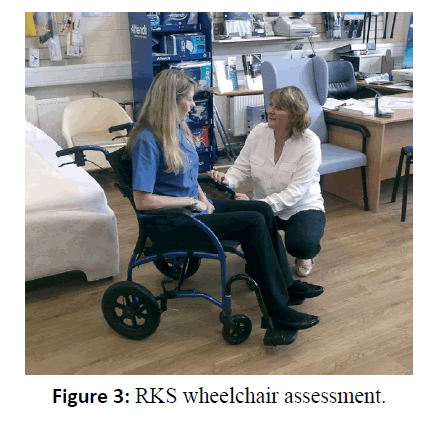
Figure 3: RKS wheelchair assessment.
Maintaining Lordosis through Exemplary Wheelchair Design
To eliminate the posterior rotation of the pelvis and concomitant flattening of the lumbar spine, the angle between the hip and the trunk needs to be increased Keegan, thus a greater reduction in hip flexion may be achieve by assuming a semi-lying position.9 Pynt et al. also reiterated the findings of Andresson et al. that for tasks not involving a forward posture, such as sitting in a wheelchair, it has been shown when a lumbar support of 4cm depth is used in conjunction with a reclined backrest of 130 degrees, lumbar lordosis is restored close to that of standing, i.e., intradiscal pressure is decreased approximately 6% compared with erect sitting without lumbar support.2,6 Therefore, a supported ‘rear arched’ spinal position approximately 10% less than full extension can assist with better postural health.
This concept has been taken into consideration and applied in the design of a recently introduced wheelchair known as the TGA StrongBack in the UK. This Swiss ‘Strück’ product invented by Dr. Christian Grothe and Ladd Lougee supports a healthy seated posture. Three years of joint product development have resulted in an ergonomic wheelchair that incorporates a convex curved backrest to support natural lumbar lordosis. It is suitable for a wide range of extended sitting postures with minimal adjustment and includes seating material that supports tissue viability (Figure 4).
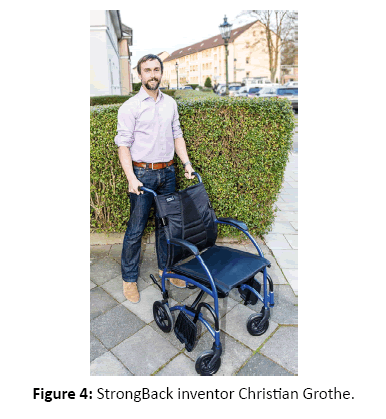
Figure 4: StrongBack inventor Christian Grothe.
Grothe has a PhD in Engineering and has primarily worked in the field of Aviation research however following several years working in community equipment services across Europe; he has gained first-hand knowledge regarding the pain and discomfort associated with many conventional wheelchairs. Grothe comments: “With traditional vertical backrests, users always slump in their wheelchair and adopt an unhealthy seated position. This is because the conventional wheelchair geometry makes effortless upright sitting impossible.” The folding StrongBack employs an effective, ergonomic curved lumbar support that is integrated into the frame. It provides a standard, non-bespoke wheelchair that does not require additional postural supports in many circumstances so that optimum lumbar support and comfort is provided for a wide range of occupants.
Lougee also states in summary that: “We know that many people suffer from backache in their traditional wheelchair due to poor ergonomics. The lightweight, folding StrongBack has a backrest that is geometrically more in-keeping with the natural curvature of the spine so extended periods of sitting will not result in chronic pain or other associated health and well-being problems. Added to this, firm yet appropriate lateral support will keep the pelvis mid-line so spinal curvature can be prevented in both planes. The importance of a well-fitting wheelchair is a vital consideration to maximize users Occupational Performance. Through evaluation of clinical evidence, considered R&D and end user testing we have been able to develop a wheelchair that will provide better lumbar support, better posture and a better quality of life.”
The Role of the Care Manager
Care managers have a duty of care to provide all patients, residents and clients with equipment that is necessary and appropriate. A wheelchair that helps promote healthy posture and improves the well being of the occupant should be seen as a ‘need’ and not a ‘want’. Provision of poorly designed wheelchairs with inadequate lateral and back support can facilitate the development of many chronic conditions along with increased pain and discomfort. Both in the short and long term this can result in a greater need for intervention from other areas of healthcare and hence increase strain on available resources. By providing access to well designed wheelchairs with effective lumbar support, care managers can ensure a more positive outcome for users whilst optimizing care and equipment budgets (Figure 5).
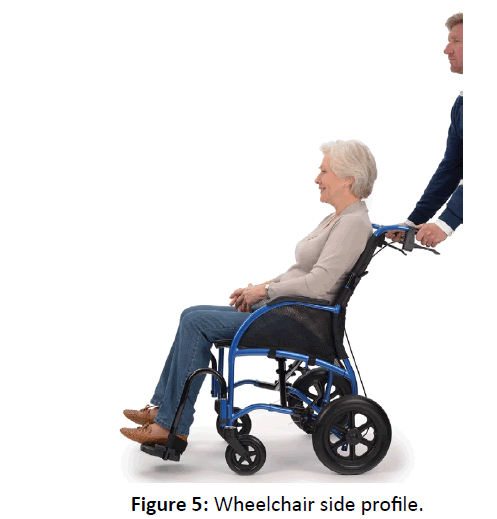
Figure 5: Wheelchair side profile.
Conclusion
Promoting Occupational Performance is important to a wheelchair user to ensure they have a good quality of life and maintain their wellbeing and confidence. This is achieved through being able to perform every day activities with independence and ease from an appropriate and well-designed wheelchair. Using a wheelchair that has effective lumbar support and promotes healthy posture can produce a significant improvement in Occupational Performance.